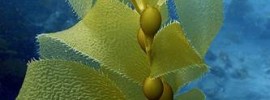Okay… not “shit”… but I meant “cool!” Going green and eating green foods is definitely cool. But it doesn’t have to be hard to eat food that is free of chemicals and poisons. Being green has come to mean many things, but for most, it stands for reducing your footprint upon the earth, therefore eating green means to make sure the food on your table didn’t travel too far to get to you.
The Real Lowdown on Spirulina
The UN once declared Spirulina the “best food of the future”. Is it just sensationalism? After all, it’s only a microscopic, blue-green algae. Used by the Aztecs and Mesoamericans since the 16th century, few know that its history goes even further back to 9th century Chad. Presently, it is cultivated and eaten in over 70 countries as a dried powder or pill.
Simply Seaweed for your Health
Drawing their nutrition from the ocean and seas, kelp and seaweed are extremely rich in iodine and calcium, as well as many other vitamins and minerals. Depending on the strain, seaweed can be high in protein (Spirulina) or Vitamin C (red and brown algae). And, although these aquatic plants are low in fat, they have a higher content of essential fatty acids than land plants.
Allergies Bothering You? Natural Antihistamines!
Ugh! The weather outside is beautiful – the sun is shining, the trees are blooming and the air finally feels tolerably warm. So why do I find myself suffering? The answer is – seasonal allergies. I knew a few other people, too, with this problem, so I decided to do a little investigation into the field of natural antihistamines.
Are You Eating Your Algae?
Allow me to introduce you to Spirulina, most recently deemed the super-est of all super foods. Spirulina, a form of blue-green algae, boasts 10 times more beta carotene than carrots, is about 65% protein and provides us with essential fatty acids, phytonutrients, probiotics, and antioxidants. Consuming spirulina (algae) has been linked to recovery from diseases like Cancer, ADD, and Autism.




